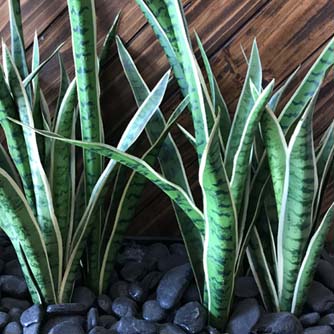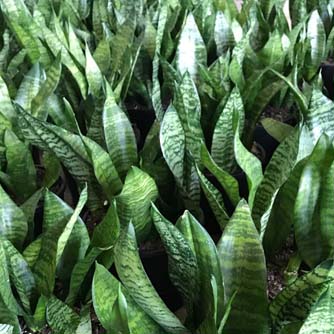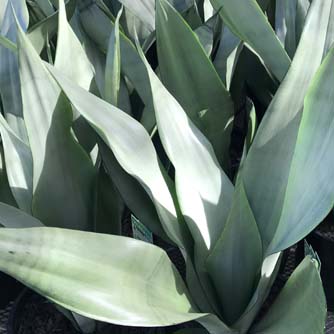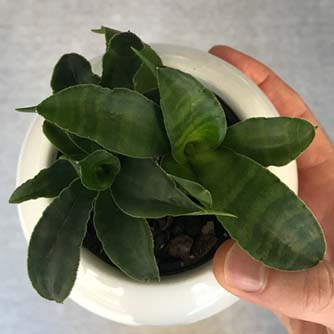Sansevieria
BackSansevieria is a resilient plant with thick succulent leaves that can store water for long periods making it an excellent choice for containers and indoor use. Commonly known as mother-in-laws tongue or snake plant it has come back into fashion as it suits the clean look of modern styling. Add in the fact that it can thrive on neglect and we have the perfect plant for today’s busy lifestyles.
There are around 70 species of sansevieria originating from Africa and Southern Asia. Previous they were in their own genus but most sansevierias have been moved into the dracaena genus. The best known plant is Dracaena trifasciata however in recent years we’ve seen a dramatic increase in the number of species and cultivars now sold in nurseries giving us a broader range of leaf shape and colour. Try planting them en masse in a low bowl to make a real statement or as a single plant in a beautiful pot.
How To Grow Sansevieria
Sansevieria are one of the easiest indoor plants to grow as they require very little attention once established. While they can grow in poor light, sansevieria perform best in bright, indirect light where they grow faster with enhanced foliage colours. Avoid hot direct sunlight as the leaves can scorch and burn.

Dracaena trifasciata 'Laurentii' - better known as mother-in-laws tongue or snake plant
It’s important to not over water sansevieria as this will lead to rot developing. So if you tend to be a heavy handed waterer then pot them up using a cactus and succulent potting mix with enhanced drainage. Otherwise a premium potting mix will be okay. Water in with some OCP eco-seaweed to help reduce transplant shock.
Weed Alert: In warmer climates sansevieria can become a garden escapee if planted outside. Stick to growing in pots and always dispose of clippings responsibly to prevent this problem.
Fertilising and Maintenance of Sansevieria
As already mentioned, these are easy care plants so there’s only a few things to keep in mind. Water when the soil has dried out completely and check that the pot isn’t continually sitting in a saucer filled with water. During the warmer months sansevieria are actively growing and will use more water but need less in winter when they’re inactive.
If you want to promote faster growth then apply a mix of OCP eco-seaweed and OCP eco-aminogro every 2 weeks. If you’re happy with the size of your plant then a monthly application is all that’s needed to maintain healthy plants with strong foliage colour.

Sansevieria can also be impressive when massed together
Sansevieria can cope with being crowded in a pot for a long time but will eventually break or distort the pot so at some stage you will need to repot. This is best done in the warmer months when plants are actively growing. See below for tips on dividing plants.
Propagation of Sansevieria
Dividing Clumps – remove from the pot and shake off excess potting mix. If possible simply pull the clump apart into smaller sections. If the clump is really overgrown use sharp secateurs and cut the clump into smaller pieces. Repot the new sections into fresh potting mix and water in with eco-seaweed. Take care not to overwater during the first month as the new plants establish.
Leaf Cuttings – choose a healthy leaf and cut into smaller pieces about 8cm high. Fill a pot with cactus and succulent potting mix and insert the cuttings about 2cm deep. Make sure the cuttings are inserted the right way up and press the potting mix down so they are firmly held in place. Water in with eco-seaweed and then place a plastic bag over the top to create a mini hothouse. Check on them weekly and if the soil is dry water again with eco-seaweed but do not over water. New leaves will form from the base of the cutting over several weeks with the original piece of cutting eventually dying off.

Striking silver foliage of Dracaena 'Silbersee'
Pest and Disease Problems for Sansevieria
Overwatering – this is the most common problem causing brown squishy leaves as rot sets in. Remove all damaged parts and repot with fresh cactus and succulent potting mix. Water in with eco-seaweed and then reduce your watering frequency.
Mealybugs and mites – these are common pest problems for many indoor plants including sansevieria. Tackle these pests with a spray of OCP eco-oil or OCP eco-neem. Check plants thoroughly as repeat sprays may be needed.
Scale - spray with a horticultural oil if these pests appear.
Lack of water – as these plants tolerate long periods without water, we sometimes completely forget to water them! This will show up as dry and crinkled leaves. Pep them up quickly with a good soaking of OCP eco-seaweed and OCP eco-hydrate. Then keep them happy with a monthly dose of eco-seaweed and eco-aminogro.

Small growing sansevieria 'Tom Thumb'


